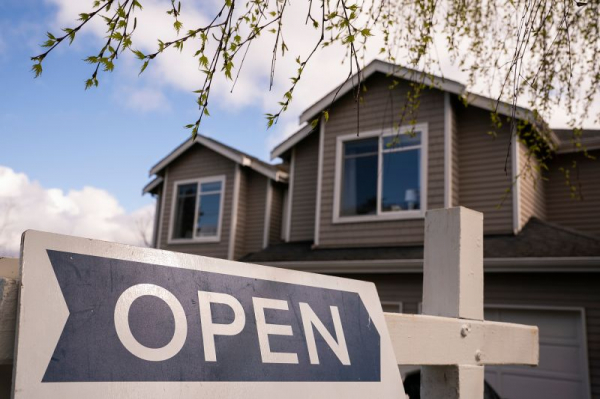Unexpected Surge: US Pending Home Sales Defy Expectations Despite Rising Mortgage Rates
Despite a backdrop of elevated mortgage rates in March, the housing market in the United States witnessed an unexpected surge in pending home sales, according to recent data. Contrary to forecasts, pending home sales, a forward-looking indicator based on contract signings, soared by 3.4% in March, marking the strongest performance in a year, as reported by the National Association of Realtors (NAR) on Thursday.
The robust increase in contract signings surpassed economists' expectations, who had anticipated a slight decline of 0.3%, according to a FactSet poll. This surge was widespread across the country, with the exception of the Midwest region.
However, despite the March uptick, NAR's chief economist, Lawrence Yun, noted that pending home sales have remained relatively stagnant over the past 12 months, lacking significant momentum. Yun emphasized that meaningful growth would likely require a combination of declining mortgage rates and increased housing inventory.
The positive momentum in the housing market at the start of the year, characterized by rising home sales and improved homebuilder sentiment, has encountered headwinds. Existing home sales, which constitute the majority of the housing market, witnessed a significant decline in March. This shift in the narrative is attributed to hotter-than-expected inflation readings, deterring the Federal Reserve from implementing interest rate cuts, and subsequently leading to a surge in bond yields.
Mortgage rates have escalated, with the average 30-year fixed-rate mortgage surpassing 7% last week, driven by the surge in bond yields. Economists anticipate that rates will remain high throughout the year, dampening the outlook for home sales. Oliver Allen, senior US economist at Pantheon Macroeconomics, anticipates a significant drop in pending home sales in the coming months, citing weakening mortgage demand.
In addition to rising mortgage rates, housing affordability continues to be a concern, exacerbated by escalating home prices and a persistent shortage of homes on the market. The median home price in the US reached $393,500 last month, marking a 4.8% increase from the previous year and the highest March price on record.
With the S&P Global index of home prices expected to reach a record high in January, the challenges of affordability and inventory constraints persist, posing hurdles for prospective homebuyers in the US market.
Challenges Persist as Housing Inventory Inches Up but Fails to Match Demand
Recent data indicates a slight improvement in housing inventory, yet it remains insufficient to meet burgeoning demand, intensifying pressure on prices in markets facing shortages. According to figures from the National Association of Realtors (NAR), the inventory of unsold homes increased by 4.7% in March compared to the previous month, reaching 1.11 million units, a 14.4% rise from the previous year.
One significant factor contributing to the housing shortage is homeowners' reluctance to sell, motivated by the desire to maintain their advantageous mortgage rates, often referred to as "golden handcuffs." This trend emerged in early 2022 when the Federal Reserve began raising interest rates to combat inflation. While homeowners have opted to stay put, life events such as marriage, divorce, or expanding families may compel some to reconsider and list their homes for sale, according to Lawrence Yun, chief economist at NAR.
Mortgage rates continue to climb, with the average 30-year fixed-rate mortgage reaching 7.17% in the week ending April 25, marking the highest level since late November. Despite this increase, home purchase demand remains resilient, indicating that buyers are adapting to the elevated rates. Sam Khater, chief economist at Freddie Mac, noted that the sales of newly built homes witnessed the most substantial uptick since December 2022, suggesting ongoing activity in the housing market.
However, the sustainability of demand hinges on the trajectory of both mortgage rates and home prices. If these factors remain elevated, demand could weaken or stall, posing challenges for the housing market. Whether housing inventory will continue to improve remains uncertain, particularly as residential construction of single-family homes experienced a sharp decline of 12.4% in March, according to Commerce Department data.
The increase in the 10-year Treasury yield to above 4.70%, the highest level in over five months, further underscores concerns about economic growth slowing amid persistent inflation. In such a climate, the dynamics of the housing market remain fluid, with stakeholders closely monitoring developments to navigate the evolving landscape.
In conclusion, while there are signs of modest improvement in housing inventory, the persistent gap between supply and demand continues to shape the dynamics of the housing market. Homeowners' reluctance to sell, driven by favorable mortgage rates, contributes to the ongoing shortage, exerting upward pressure on prices in many areas. The resilience of home purchase demand amid rising mortgage rates underscores buyers' adaptability but raises questions about the sustainability of this trend. Moving forward, the trajectory of mortgage rates and home prices will be critical factors influencing market dynamics, while the uncertainty surrounding economic growth and inflation adds further complexity. Stakeholders will closely monitor these developments to navigate the evolving landscape of the housing market in the months ahead.








![Unmatched Excellence: 30 Years, Zero Lost Bags - The Remarkable Record of [Airport's Name]](/media/k2/items/cache/11d1150d71d7fad2b9b66fe40cd35dcb_M.jpg)



